Promoting your Shopify store is essential for its growth and profitability. A stunning website with top-notch products won’t deliver the results you’re looking for if no one knows it exists. If you’ve been grappling with the question, “How do I make my Shopify store popular?” you’ve come to the right place. This article will explore 14 proven strategies to elevate your Shopify promotions.
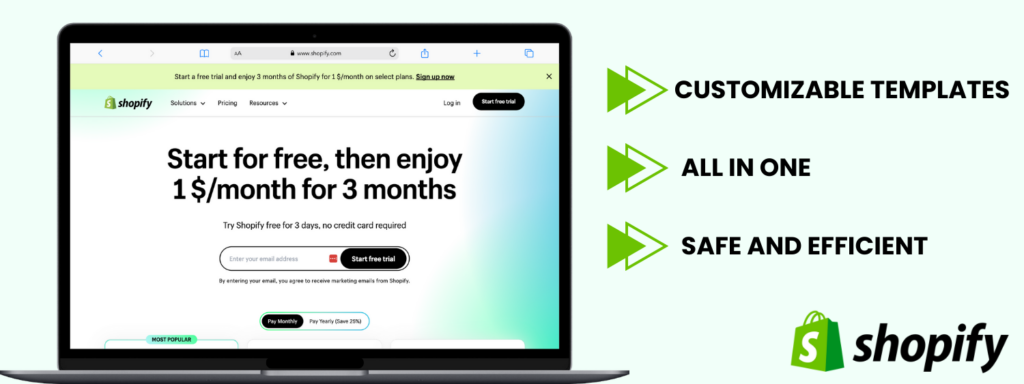
14 Promotional Strategies
Learn how to promote your Shopify store for free, or with our minimal investment tactics. Shopify marketing doesn’t need to be hard when you have the right tools. Maximize your Shopify sales with these strategies:
- Understand Your Audience
- Leverage the Power of SEO
- Master Social Media Marketing
- Focus on Email Marketing
- Tap into Influencer Collaborations
- Implement a Referral Program
- Run Targeted Ad Campaigns
- Utilize Content Marketing
- Partner with Similar Brands
- Try Offline Marketing
- Create a Google Business Profile
- Try Local Delivery
- Invest in Infographics and Good Photography
- Get Featured
1. Understand Your Audience
Before embarking on any promotional journey, decoding your audience’s ‘DNA’ is the first and most essential step. This is more than just demographic research; it’s about getting into the mindset of your customers to know what makes them tick.
Employ tools like Google Analytics and customer surveys to learn more than just age or location. Identify the challenges they face, their hobbies, how they engage with similar products, and what motivates their buying decisions. Use customer personas to visualize these findings. This well-rounded understanding will be the compass directing all your subsequent marketing strategies.
Expert tip: Tools such as Hubspot Make My Persona offer free ways to visualize your personas.
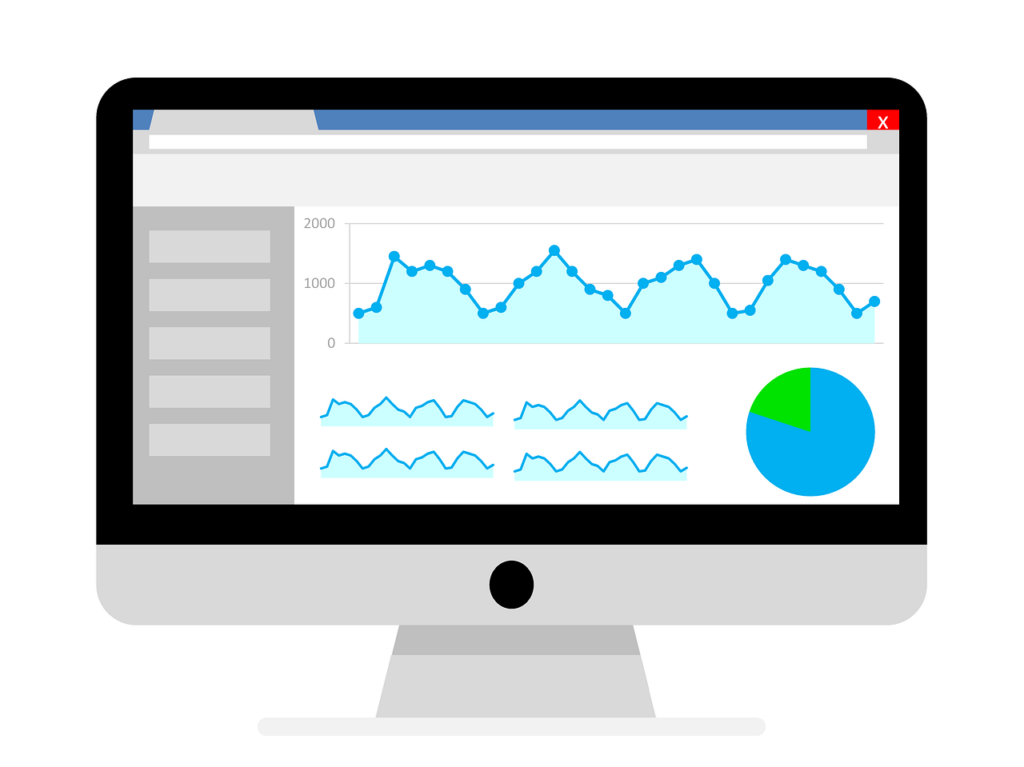
MORE: How to open a Shopify store
2. Leverage the Power of SEO
The best advertising for Shopify is leveraging the power of SEO.
Search Engine Optimization (SEO) isn’t a one-off task; it’s an ongoing process. But it’s well worth the investment of time and energy. Start with an SEO audit to identify the strengths and weaknesses of your current setup. Start by researching target keywords using free tools such as Google Keyword Planner, or paid tools such as Semrush and Ahrefs. Use these keywords to optimize your product listings, descriptions and meta descriptions. Remember other elements like your website’s URL structure, mobile compatibility, and page loading speeds.
Additionally, consider implementing schema markup to provide search engines with a clearer understanding of your page content. And if possible, create an internal linking and backlink strategy to contribute to your site’s authority.
Expert tip: Remember, SEO isn’t just about driving any traffic; it’s about attracting potential new customers who are genuinely interested in what you offer. SEO takes time, but it is worth the long-term rewards.

MORE: Shopify Reports
3. Master Social Media Marketing
Sure, everyone knows about Instagram, Facebook, and Twitter, but let’s dig a little deeper. To engage with your audience, use Instagram Stories to showcase behind-the-scenes looks at your business or conduct flash sales. On Facebook, instead of just posts, set up a Shop and utilize Facebook Groups to create a community around your brand.
TikTok — it isn’t just for teenagers and GenZ; it’s a burgeoning platform for brands aiming to reach a new audience. Short, catchy videos can go viral in hours, bringing massive attention to your products.
Starting a YouTube channel can promote your products and position you as an expert in your niche. Conduct webinars, Q&A sessions, or tutorials relevant to your product range. You can even go live across different platforms to directly interact with your audience, answer questions, and even showcase your products in real-time to enhance your Shopify promotion.
MORE: How much does a Shopify store cost?
4. Focus on Email Marketing
A well-crafted email can offer something much more intimate for your customers. To maximize the full power of Shopify advertising, segment your email lists based on customer behavior, preferences, or past purchases. This allows you to send targeted, personalized messages that resonate with the recipient.
Add a creative flair to your emails by employing gripping copy, enticing visuals, and even video content if appropriate. The subject line should spark curiosity, while the body of the email should drive home the value you’re offering. From announcing new product launches to featuring customer testimonials, emails are a versatile tool for nurturing customer relationships and driving sales.
Expert tip: Use a third-party email hosting service if you wish to send emails from an email address associated with your custom domain.
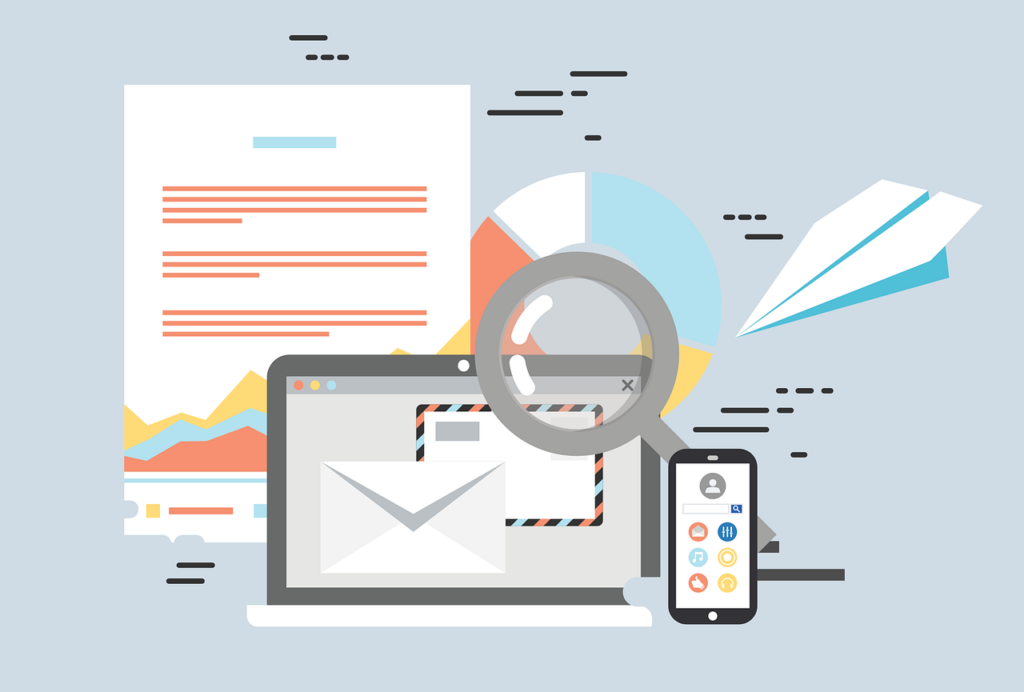
5. Tap into Influencer Collaborations
Influencer marketing is more than just finding a popular figure and paying them to pose with your product. To truly leverage influencer collaborations, seek influencers who genuinely resonate with your brand ethos and whose audience aligns closely with your target customer base.
Consider long-term collaborations like content series or even co-designed products. The goal here is to build a mutually beneficial relationship. This injects your brand into conversations happening among your target audience, but in a way that feels natural, genuine, and persuasive.
Expert tip: Contact influencers whose message and overall image aligns with your company’s mission. You can do so through Instagram directly, or contact them via email that’s usually listed in their bio.
MORE: Shopify Branding
6. Implement a Referral Program
The age-old saying that “word-of-mouth is the best form of advertising” has never been truer, especially in the digital landscape, where opinions can spread like wildfire. Empower your existing customer base to become brand ambassadors through a structured referral program.
Create an easy-to-use mechanism where customers can refer your Shopify store to their network, and in return, receive something of tangible value—be it discounts, freebies, or even exclusive access to new products.
Expert tip: You can do this through sites such as ReferralCandy.
7. Run Targeted Ad Campaigns
Try PPC (pay-per-click) advertising. PPC is a type of digital advertising where you pay a fee each time one of your ads is clicked. In addition to driving immediate traffic to your Shopify store, PPC allows for highly targeted advertising, enabling you to reach potential customers who are specifically interested in your products or services.
It is different from SEO efforts, which are often more a long-term tactic. However, it’s worth noting here that PPC can be a more expensive tactic, especially if your shop is within a competitive marketplace.
Use customer personas, and robust keyword research to target your ads precisely. This ensures that your marketing budget is spent efficiently, attracting potential customers who are most likely to convert. A/B testing your ad copy and visuals can also help refine your strategies, making every dollar spent count.
MORE: What is Shopify Plus?
8. Utilize Content Marketing
By utilizing content marketing, you could increase your Shopify sales. By crafting blogs, how-to guides, and engaging videos you establish your brand as an industry authority and cater to the needs of your target audience. The key here is relevancy and quality. Each piece of content should offer genuine value, addressing questions or solving problems your potential customers might have.
Once you’ve garnered their trust and attention, subtly introducing your products within this high-value content becomes far more effective and less intrusive. Additionally, quality content aids your SEO efforts, and could help you increase organic traffic over time.
Expert tip: Your Shopify store has a built-in blogging feature. You don’t need additional blogging tools if you’re just starting out.
9. Partner With Similar Brands
Joining forces with complementary brands can unlock mutual growth opportunities. Whether it’s co-branded products, bundled offers, or shared marketing campaigns, these partnerships can introduce your Shopify store to a whole new audience while providing added value to your existing customers.
The trick is to choose partners whose products or services align with but don’t compete with your own. For instance, if you sell specialty coffee, partnering with a well-known cookie brand for a limited-time offer can create a win-win situation. Through these collaborations, both brands can share the spotlight and benefit from combined marketing muscle.
Expert tip: Find brand partnership opportunities through social media. Find accounts that resonate with your brand and message the company to see if they’re interested in your offer
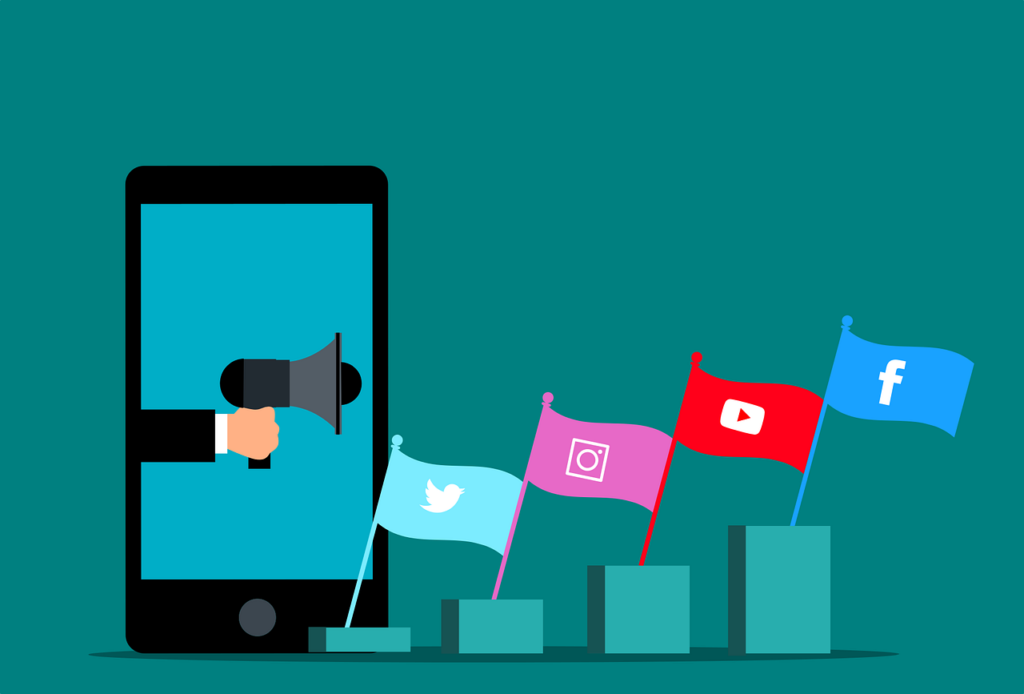
10. Try Offline Marketing
Participate in trade shows to showcase your products and engage with potential business partners. Sponsor community or local events to build goodwill and brand recognition within your immediate geographic area. You could also experiment with pop-up stores to provide a tactile experience of your products. These in-person interactions create an emotional connection with your brand, fostering loyalty and encouraging word-of-mouth recommendations.
11. Create a Google Business Profile
A Google Business Profile isn’t just an online business card; it’s your virtual storefront. By accurately listing your business details, you make it easier for local customers to find you, whether you’re an online-only shop or have a brick-and-mortar location. Reviews, business hours, and directions are just a click away, making it convenient for potential customers to engage with you.
Moreover, appearing in local searches is critical if you have a physical store or offer local delivery. Google Business Profile enhances your visibility in local search results and Google Maps, driving both physical customers to your store (if you own one)and clicks to your website.
When creating your Google Business Profile, you will need to add your Shopify store name. If you haven’t created one yet, check out our Shopify Brand Name Generator, which generates thousands of business names in seconds.

MORE: How to change Shopify store name
12. Try Local Delivery
Offering local delivery can drastically change your business dynamics. It adds a layer of convenience for local customers and sets you apart from competitors who don’t provide this service.
For example, if you’re selling handmade crafts or organic produce, the promise of quick local delivery could make you the go-to choice in your area. But of course, local delivery mostly means that the products your clients buy will be shipped cheaper (and we all want that cheaper delivery, right?).
Consider using eco-friendly packaging or personalized notes to make the delivery experience unique, enhancing customer satisfaction and encouraging repeat business.
13. Invest in Infographics and Good Photography
Visual elements like infographics and high-quality photography aren’t merely aesthetic choices—they’re strategic ones. They can capture complex data in an easily digestible format or bring your products to life in a way that words simply can’t. Infographics are particularly effective for SEO as they are often shared, thus creating backlinks to your website.
High-quality photographs can elevate the perceived value of your products, encouraging conversions. These visual elements make your content more engaging, shareable, and effective in delivering your message.
Expert tip: Use a platform like Canva to create professional-looking infographics.
14. Get Featured
There’s no advertising quite like third-party endorsement. Whether you secure a feature in a trade publication, a guest post on an authoritative blog, or even a shout-out from a social media influencer, these validations build your store’s credibility. This increases your store’s visibility and taps into new customer bases who might have yet to discover your brand.
Look for opportunities that align with your brand’s ethos and values to get featured, as this ensures that you’re reaching a targeted audience that is more likely to convert.
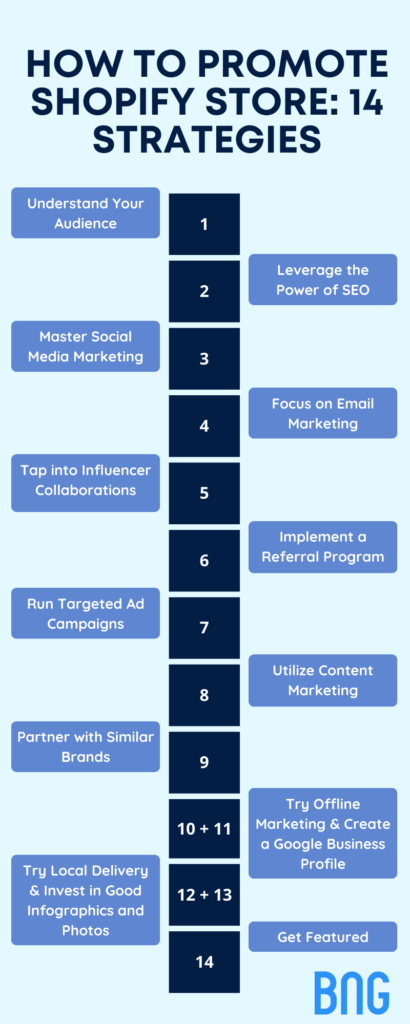
Digital Marketing Channel Statistics
In a 2022 study involving B2C and B2B marketers from several countries including Australia, Canada, France, Germany, Japan, the UK, and the US, social media emerged as the most favored digital marketing platform, chosen by 44% of those surveyed. Websites or blogs came in second at 36%, followed by email marketing at 35%.

How to Choose the Best Shopify Promotional Strategy
Not all strategies will work for every store. Mix and match these options based on your target audience, budget, and product type. Experiment, measure results, and then double down on what’s working.
When choosing the best strategies to promote your Shopify store, begin by clearly defining your business objectives. Are you looking to boost brand awareness, increase sales, or perhaps grow your email list? Each goal might require a different strategy. Let’s dive a little deeper:
- SEO and content marketing are excellent for long-term brand building, while PPC campaigns and influencer collaborations may bring quicker sales.
- Remember to assess your available resources, such as time, expertise, and budget, as some strategies require more investment in these areas than others.
- Opt for strategies which are measurable. Use analytics tools to track metrics such as conversion rates, website traffic, and customer engagement. This will help you understand the ROI of your chosen strategies and provide insights into customer behavior and preferences.
- Consider the platforms your potential customers frequent, the content they engage with, and their shopping behaviors can all inform your marketing decisions. For example, if your target audience mainly comprises young individuals, social media marketing and influencer collaborations might be more effective.
- On the other hand, if you’re targeting a local or potentially an older demographic, offline marketing and a strong Google Business Profile could be more beneficial.
- Tailoring your strategies to your audience ensures that your marketing efforts are designed to reach the people most likely to convert into customers.
Takeaway Points
Successfully promoting your Shopify store is more than just a one-off effort; it’s an ongoing process that demands a strategic approach, meticulous research, and the willingness to adapt and fine-tune your methods. The tactics highlighted in this article provide a roadmap to increase your store’s visibility, drive targeted traffic, and ultimately, ramp up your sales figures.